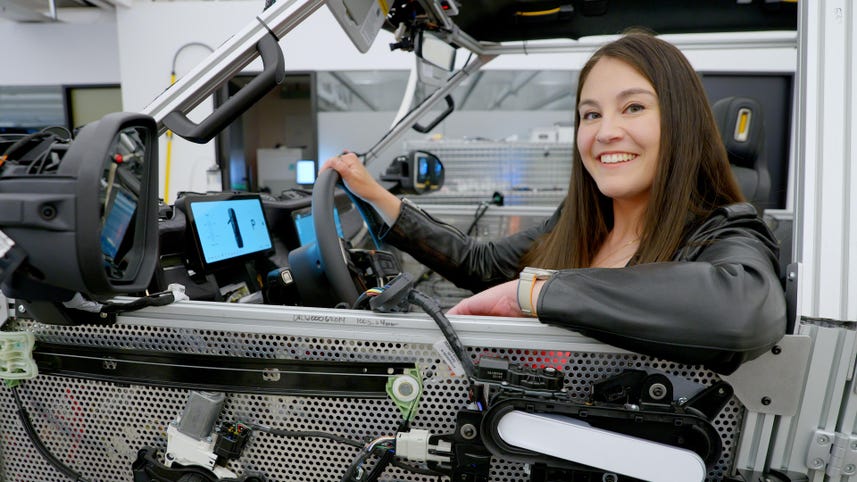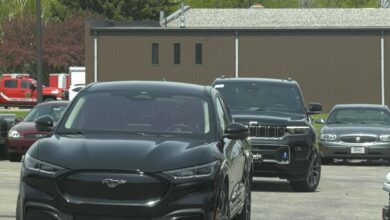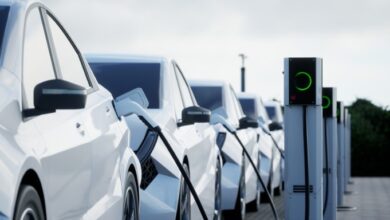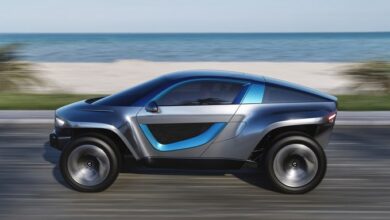See Inside Rivian’s Electric Vehicle Test Labs – Video


Speaker 1: Rivian is gearing up to launch. Its second generation R one and I’m here at Rivian in Palo Alto to give you a sneak peek behind the scenes to see how all the hardware and software comes together.
Speaker 2: Oh,
Speaker 1: Wasn’t explaining that this
Speaker 3: Is addictive.
Speaker 1: I am driving the new R one s and it doesn’t look that different on the outside from the first version, but there are hundreds of changes inside like [00:00:30] re-engineered suspension motors and battery packs of fun user interface, new interior finishes and new 4K HDR cameras. Rivian invited us for an exclusive look behind the scenes in these test labs that bring the hardware to life video. You didn’t tell me you worked in the real life Transformers lab. What is
Speaker 3: This? So this is what we call a lab car. This is where we put together all the electronics that belongs in the vehicle together without the actual body, and this is how we get to test [00:01:00] to see that it actually works. This gives you a sense of just the amount of electronics that exists in the modern vehicle. Everybody talks about it, but gives you a way to actually literally see it’s a high performance imaging radar. And down here, high compute systems. This is the autonomy experience module. This is the unit that has over anywhere between six to 12 times a computer of what you’d get in terms of ai, computer and Apple M four. For example,
Speaker 1: The lab car has [00:01:30] most of the same components as a production vehicle, apart from elements like the motor and wheels. So you can test updates for the displays, headlights, blinkers, and more.
Speaker 3: You can do everything you do in a vehicle, but the advantages as you do it, you can actually look at the electrical signals and in the solar scope you can monitor everything and make sure it’s really performing at spec. What we’re testing is integration testing. So when I put a whole bunch of things together, do they behave like I thought they would. Not only are you testing for normal operation, you’re testing [00:02:00] for fault scenarios too, which you have to be very careful with the vehicle. So we test a lot of fault scenarios. We force a short on a wire and see how the vehicle responds.
Speaker 1: So you’re deliberately doing little sabotage tests to really get to the bones of how this
Speaker 3: Performs. Exactly.
Speaker 1: Powering all these components is a new electrical architecture rivian design from scratch in this hardware lab,
Speaker 3: The ECU that stands for electronic control units, but they’re really the brains behind all the operations of the vehicle [00:02:30] and they’re dispersed all over the vehicle and they do different things. They’re the things that help you open your windows. They’re the things that help you navigate, show you where you’re going. They’re the things that control the temperature. This one is what we call our autonomy experience module. It really does two things. It controls all the autonomous driving functions, but it also has an ECU that controls the display and the navigation and controls how music gets when you pair [00:03:00] Bluetooth to your vehicle and what’s on your phone gets played.
Speaker 1: Many cars currently use an electrical infrastructure called domain architecture, which organizes these ECUs by function, but EV makers like Rivian and Tesla are moving to a newer zonal architecture, which consolidates them based on their location in the car.
Speaker 3: The way we put things together is really looking at functions that control a particular area or a zone and try to put those together. We took a whole lot of ECUs [00:03:30] and really consolidate them into three and they’re called zonal controllers.
Speaker 1: Using a zonal system helped reduce the number of ECUs from 17 down to seven three. ECUs now control everything except the entertainment, autonomy, vehicle access, and battery management systems, which have their own ECUs. This shapes off 44 pounds of weight and gets rid of 1.6 miles of wiring for you as the driver though. This all comes down to two things, better reliability and range. There’s fewer points of failure [00:04:00] and a lighter car helps you go further on a charge, but it’s one thing to test in a lab car and it’s a whole other thing to test in the real world. This is the garage. This is where Rivian does a lot of real world testing of its vehicles.
Speaker 4: First of all, welcome to our Palo Alto Shop. Thank you. This is where the magic of the hardware software integration happens. Our customers love the exterior design, so we did not do that many [00:04:30] changes, but then we changed the lighting. As you see here, it’s much more refined and then we have this new charging animation. These lights, by the way, are also RGB, so there will be lots of Easter eggs for our customers to see many more colors.
Speaker 1: This is a new user interface powered by Unreal Engine, a 3D engine used by video game designers and it helps render these real-time graphics and animations. You change the entire driving configuration from this screen and I was surprised by how I could instantly feel the [00:05:00] car alter the ride height and suspension when switching between Drive modes. Other software features like an automatic lane change feature and adaptive driving beam on the headlights will roll out later in the year. You mentioned one of the most requested features was that blind spot features that’s rolling out. What else is there that customers have been asking you for that you haven’t quite implemented yet? That is number one. On the wishlist of Rivian customers,
Speaker 4: There’s few number ones. So actually, so blind spot, which is, I mean, again, [00:05:30] I love this feature and really the nice UI design that we did with our UX team. This isn’t the number one in the top three I’d say we have the Gear Guard streaming, so it’s the possibility for our customers to view what’s happening outside the vehicles on their mobile phone. So this is, okay, another scoop for you. This is something coming in Q3, so we will have that as part [00:06:00] of one of our Q3 OTAs. Love it. The other features that are in the really top list of customer asks is integration of Apple Music as additional music streaming feature. See, you have another
Speaker 1: Scoop. See, I know know a lot of people have been asking for that. Yes, better music integration, more apps. I love that one
Speaker 4: In the list of top five using Apple Watch and [00:06:30] you’ll actually, I’ll be able as well to open a Ian second generation with your Apple Watch or Google Watch moving forward.
Speaker 1: In terms of, obviously AI is such a big buzzword in the tech world right now and there’s a lot of promise and a lot of under delivery so
Speaker 4: Far. With this second generation, we’re introducing a new compute from an autonomous standpoint. This is eight x AI [00:07:00] capabilities, so that is the foundation of what we call now the Arabian autonomy platform, which will have an expanded feature set as we move forward with our software. We’re working, this is another secret, but to really have a much better voice assistant experience. This is something that we did not want to announce yet for the very valid point that you raised. I really personally think that what heard a lot of [00:07:30] announcements in the AI space is that its products in some cases which are half baked and users expect much bigger reliability from AI. Users expect to have great performance, to have really low latency, whether you’re connected or not, you can imagine a world where your vehicle will predict the issues which are happening. Your vehicle will have connection with our cloud, [00:08:00] our reliability data, and then your vehicle through that direct to consumer service relationship can automatically book an appointment for you or can automatically have a rivian mobile van come to your house to repair any potential service issue.
Speaker 1: Now it’s my turn to get into the driver’s seat. This is the R one S dual motor with max battery pack with up to 420 miles of range and it can do zero to 60 in 3.5 seconds. [00:08:30] Unfortunately, I didn’t get to try out the quad motor R one T that can do zero to 60 in under 2.5 seconds when using launch mode. But given I was driving on the residential streets of Palo Alto, that’s probably a good thing. I’m surprisingly scared as someone who has driven for many, many, many years driving an EV for the first time. There’s a lot of pressure on this, so this is nice. This is what EM was [00:09:00] telling me about that blind spot indicator. So when my indicator comes on, the screen automatically pops up on one side or the other and it’s just that live view. I’m old school, I’m still going to check my blind spot when I turn, but it is really, really nice to have that second view there.
Speaker 5: Of course,
Speaker 1: There’s a speed checked by radar sign right there.
Speaker 5: Oh,
Speaker 1: I wasn’t expecting
Speaker 5: That. [00:09:30] This is addictive, so
Speaker 1: My regular combustion vehicle has turbo, but it doesn’t respond like that.
Speaker 5: Wow.
Speaker 1: As someone new to the world of EVs but has been covering tech for a really long time, it was really, really fascinating to see that intersection of hardware and software here at Rivian as well as taking a very Silicon Valley approach to a very traditional [00:10:00] automotive industry. And I also really felt like when I was driving the vehicle, interacting with the screens and driving and changing all of those settings really did feel almost like an extension of the things that I’m using in my everyday life from my smartphone to my laptop. That real mentality in how I use my device kind of now translates to the car itself, and it was just fascinating to get to see every single component inside the vehicle that you would never, ever get to see as a customer. [00:10:30] Hey, thanks so much for watching. I hope you had as much fun watching this as I did making it. I’ll catch you next time. Hey, peace. Let’s take my car.



